
And be prepared for a tough assignment. Despite extensive and continuing editing, the article is long and dense, and you may find some parts heavy going. Certain sections are unavoidably long, because this website is the only place on the web where they exist, and shortening them would be a disservice.
So please remain patient, ward off cynicism, keep an open mind and press ahead. Your tenacity will be rewarded.
Your understanding will be greatly enhanced if you start by flipping through the 30 slides below, which summarise the Newcreate way of thinking, doing and being. They are the same as the ones appearing on the home page, so perhaps you have seen them already.
Download the slides (pdf document)
Download a pdf version of this article
Contents
Mundane world and primal world in brief
Why transcend the mundane?
Transcend the Mundane is one of the Newcreator’s three superpowers
Constituent creative powers:
Mundane world and primal world in more detail
The tonal and the nagual, and left-right correspondences
Intent, the generative impulse
- What is intent?
- What intent is not
- What is intent’s purpose?
- What is the source of intent?
- Channelling intent: the radio metaphor
- Some others who have written about intent
How might the mundane be transcended?
Endnotes
Mundane world and primal world in brief
Mundane world
Corresponds with the brain’s left hemisphere, leftside, first attention, the tonal, synthetic imagination.
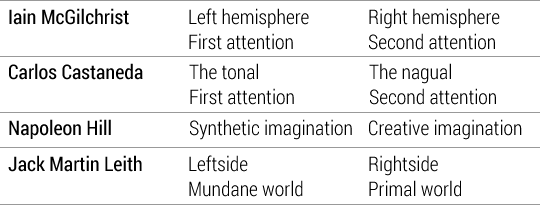
Mundane world is the everyday world, a default reality where people spend most of their waking lives. It is a world of descriptions. If something can be named, described and explained, it’s part of mundane world. Mundane world is the sum total of everything we know and everything the rational mind can imagine.
Read more about mundane worldThe first attention basically consists of everything that ordinary man considers it means to be human. It is the reality that has been constructed and developed in order to deal with the daily world and encompasses an awareness restricted to the physical body.
Lorraine Voss, Female Warrior (view)
Primal world
Corresponds with right hemisphere, rightside, second attention, the nagual, creative imagination.
Primal world is an indescribable place of pure perception. This world cannot be explained or proved to exist; it can only be experienced. Primal world is raw reality, untamed, unfiltered, uncodified and unconceptualised.
When you are immersed in primal world you are able to channel intent, the generative impulse that streams from the unmanifest into the manifest through the gap in time, activating creative imagination and infusing your work with purpose, vitality, meaning and joy.
Jump ahead and read more about the two kinds of imagination: synthetic and creative
Why transcend the mundane?
Newcreators transcend the mundane in order to enter primal world and become a channel for intent.
Intent has two aspects. One is the originating aspect, which seeks to initiate new creations. The other is the fulfilling aspect, which seeks to bring these creations to fruition and fully realise their value generation potential.
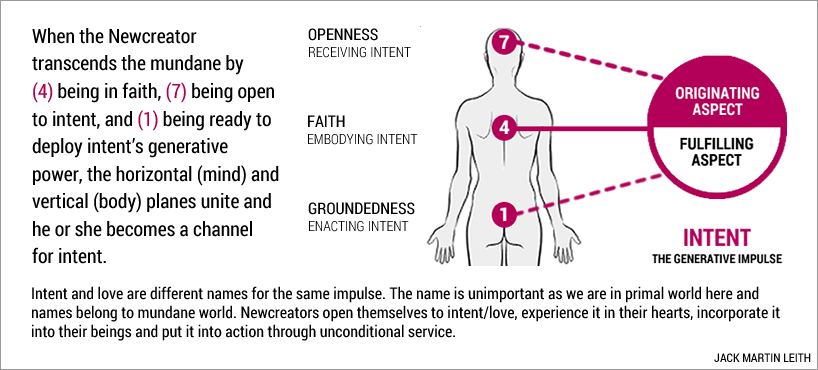
By becoming a channel for intent, your creative (in contrast to synthetic) imagination is awakened, enabling you to envision possibilities for enriching the world, or a particular piece of it, with value, meaning and joy.
Also awakened is the power required to bring into being new creations that convert these possibilities into actuality.
Newcreators do not shun mundane world. Rather, they inhabit whichever world is right for the task in hand. For example, primal world is where they imagine world-enriching possibilities, and mundane world is where they make plans for actualising these possibilities and put their plans into action.You have to understand that there are dimensions. In the dimension we call the world1, a person needs logic. He needs it badly. He needs to be able to analyze and take apart things and put them back together again. He needs to spot flaws in reasoning and multiple deceptions. He needs to recognize formal arguments and trace them all the way through from assumptions to conclusions. But in the dimension where creative power operates2, where things happen that most certainly impact this world, all bets are off. He needs to understand and experience and launch a kind of vast freedom for his own imagination that takes him entirely out of the realm of being a normal person, a foolish and provincial “realist,” a mechanically thinking human. He has to go light-years past that. He has to stop pretending he is some kind of scientist. In other words, he has to stop burying his own power. Two dimensions, two capabilities.
Jon Rappoport, The Magician Awakes, cited in The Space, the Magician, and the Man of Science, also by Jon Rappoport
1. Mundane world.
2. Primal world.
Transcend the Mundane is one of the Newcreator’s three superpowers
The superpower Transcend the Mundane is a synthesis of the creative powers Openness, Faith and Groundedness.
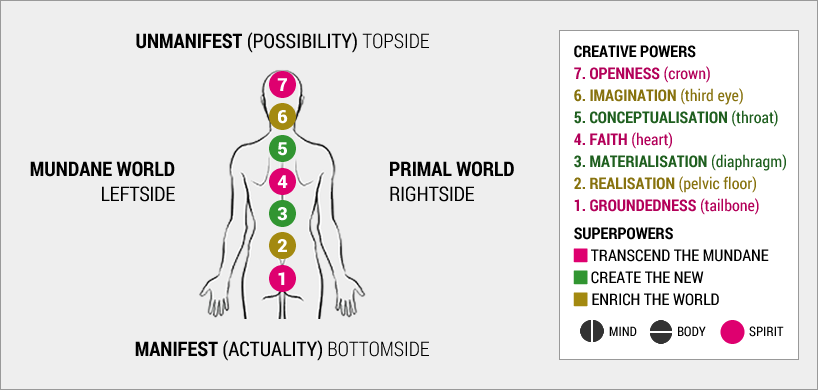
The creative power of Faith
For the Newcreator, faith — of the kind described below by Jay B. Gaskill and Peter A. Georgescu — is paramount.
Faith is a much-abused term, often derided in modern secular circles as the blind obedience to some arbitrary authority. But it has a wiser and more useful meaning: faith as a critical but curious mind’s readiness to adopt a reality model (even if provisionally) for which there is less than absolute, empirical proof. I propose that this kind of faith is the necessary adaptation by any rational rational to the challenges of life in the real world in which reality presents us with far too much, far too quickly. Events, personalities and relationships that carry embedded meaning and value are not the sorts of existents that can pass any rigid absolute-empirical-proof test. All trust relationships contain a measure of faith.
Jay B. Gaskill, The Dialogic Imperative
Faith represents an existential commitment of the heart, a way of life, a set of behaviors and emotional responses woven into every hour of everyday life — expressed through constant choices both when alone and in social situations.
Peter A. Georgescu, Faith isn’t irrational, but beliefs may be, on Huffington Post | Peter A. Georgescu is Chairman Emeritus of advertising agency network Young & Rubicam, Inc.
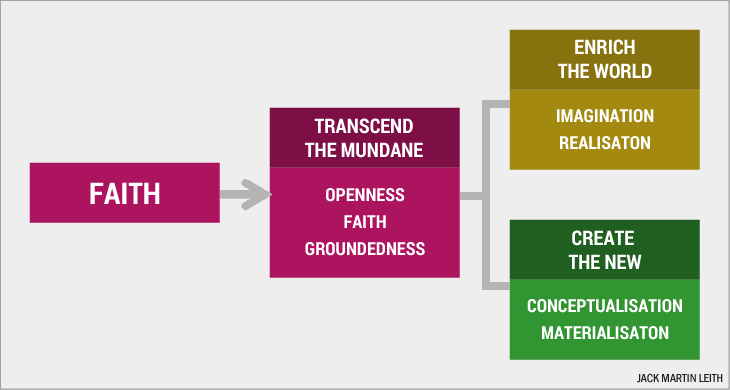
Faith is a precondition for activating the three superpowers.
Without faith, the superpower Transcend the Mundane will remain dormant, because the rational mind will reject the idea of enriching the world through unconditional service, and it will refuse to acknowledge the reality of the generative impulse named intent, of which more in a few moments.
Read more quotes about faithFAITH is the only agency through which the cosmic force of Infinite Intelligence3 can be harnessed and used by humanity.
Napoleon Hill, Think and Grow Rich!
3. Infinite Intelligence and intent have very similar meanings. Read about Infinite Intelligence
Read about unconditional service
Until Transcend the Mundane has been activated, the superpowers Enrich the World and Create the New will be unavailable, primal world will be inaccessible, intent will be absent, and the synthetic form of imagination will prevail.
Newcreators must put logic on hold, quieten negative self-talk, silence the inner critic, set aside scepticism and proceed with playful curiosity, an experimental attitude and trusting acceptance. Proof will show up along the way, vindicating earlier faith.
Stages of faith development
No hard-and-fast rule requires that people pursue faith by going through all six stages. There is a high probability for people to be content and fixed in a particular stage for a lifetime; stages 2–5 are such stages. Stage 6 is the summit of faith development. This state is often considered as “not fully” attainable.
- Intuitive-Projective: confusion and of high impressionability through stories and rituals (pre-school period).
- Mythic-Literal: provided information is accepted to conform with social norms (school-going period).
- Synthetic-Conventional: the faith acquired is concreted in the belief system with the forgoing of personification and replacement with authority in people or groups that represent one’s beliefs (early late adolescence).
- Individuative-Reflective: the person critically analyzes adopted and accepted faith with existing systems of faith. Disillusion or strengthening of faith happens in this stage. Based on needs, experiences, and paradoxes (early adulthood).
- Conjunctive faith: people realize the limits of logic and, facing the paradoxes or transcendence of life, accept the “mystery of life” and often return to the sacred stories and symbols of the pre-acquired or re-adopted faith system. This stage is called negotiated settling in life (mid-life).
- Universalizing faith: this is the “enlightenment” stage where the person comes out of all the existing systems of faith and lives life with universal principles of compassion and love and in service to others for uplift, without worries and doubt (middle-late adulthood, 45–65 years old and beyond). [This is the kind of faith that Newcreators seek to attain.]
Sourced from a past Wikipedia entry for Faith, itself based on the work of James W. Fowler. Wikipedia contributors have since reworked the text and incorporated it into the Wikipedia entry for James W. Fowler. Read more here: The Stages of Faith According to James W. Fowler by Thomas Armstrong.
The creative power of Openness
The creative power of Openness establishes a connection to the unmanifest realm, the realm of possibility, and to the originating aspect of intent, which seeks to initiate new creations.
Openness is a state of being and therefore hard to put into words, but it’s something like being inviting, receptive and hospitable.
When you are in a state of Openness, it is as though the top of your head is a satellite dish, receiving signals from who knows where.
The creative power of Groundedness
The creative power of Groundedness establishes a connection to the manifest realm, the realm of actuality, and to the fulfilling aspect of intent, which seeks to bring these creations to fruition and fully realise their value generation potential.
When you are in a state of Groundedness, it is as though there is an earth rod connecting your tailbone to the ground beneath your feet.
You are ready to say ‘Yes’ to whatever you may be called on to undertake, and prepared for action.
Jump ahead and read more about the aerial and earth metaphor
Mundane world and primal world in more detail
Mundane and primal are the adjectives I chose to describe the two worlds.
Iain McGilchrist, originator of the contemporary theory of how the brain’s hemispheres differ in the way they attend to the world, talks about two worlds but without using labels such as mundane and primal.
There’s a problem here about the nature of the two worlds. They offer us two versions of the world and obviously we combine them in different ways all the time. We need to rely on certain things to manipulate the world but for a broad understanding of it we need to use knowledge that comes from the right hemisphere.
Iain McGilchrist, The Divided Brain and the Making of the Western World — quoted passage begins at timestamp 22:30Running time 32:11
Mundane world
Mundane world, where you spend most of your waking life, is a two-dimensional world of descriptions. If something can be named, described and defined, it is part of mundane world.
Situated in mundane world, you think you are experiencing the meal but in fact you are eating the menu.
As if that isn’t bad enough, possibilities for generative thought and action are hampered by a barrage of rules, norms, codes, beliefs, dogmas, narratives and ideologies.
Mundane world is brought forth by the brain’s left hemisphere.
Iain McGilchrist lists these left hemisphere characteristics among others:
- Attention is local, narrow, focused.
- Seeing parts, not wholes.
- Seeing an inanimate world of things.
- Thinking is decontextualized and systematic.
- Closing down to certainty.
- Seeing the world as something like a map, a schema, a diagram, a theory — something two dimensional.
- Helping us manipulate the world.
- Dealing with static things.
- Living in the body, rather as we drive a car.
These give rise to a flawed worldview, resulting ultimately in ineffective create-the-new work and reduced or non-existent downstream value.
Read more here.
Two kinds of imagination: synthetic and creative
In his classic 1937 book Think and Grow Rich (pdf of entire book), Napoleon Hill contrasts creative imagination with synthetic imagination:
Synthetic imagination corresponds with leftside and mundane world. Creative imagination corresponds with rightside and primal world.SYNTHETIC IMAGINATION: Through the faculty of synthetic imagination, one may arrange old concepts, ideas, or plans into new combinations4. This faculty creates nothing. It merely works with the material of experience, education, and observation with which it is fed. It is the faculty used most by the inventor, with the exception of he who draws upon the creative imagination, when he cannot solve his problem through synthetic imagination.
CREATIVE IMAGINATION: Through the faculty of creative imagination, the finite mind of man has direct communication with Infinite Intelligence5. It is the faculty through which ‘hunches’ and ‘inspirations’ are received. It is by this faculty that all basic, or new ideas are handed over to man.
4. Today, this is known as combinatorial creativity.
5. Napoleon Hill’s Infinite Intelligence is similar in meaning to Edward Matchett’s media (see other terms he used) and Carlos Castaneda’s intent | Read more about Infinite Intelligence
Leftside is both an enabler and a tyrant, enabling you to get things done but making you a slave to reason, demanding the use of synthetic imagination and insisting that creative imagination does not and cannot exist.
Primal world
Primal world is a place of pure perception: unfiltered, uncodified and unconceptualised. It is a world you would be very familiar with if raised in the wilderness by wolves. Primal world cannot be described; it can only be experienced.
The doorway to primal world is the brain’s right hemisphere as described by Iain McGilchrist.
These are some of the attributes he lists:
- Attention is global, broad, vigilant, flexible, sustained.
- Seeing the bigger picture and seeing things whole and in their context.
- Seeing an animate world where things presence to us, rather than being re-presented.
- Opening up to possibility.
- Seeing the world that is being mapped.
- Helping us understand the world.
- Perceiving things in motion and in practice.
- Living the body.
The tonal and the nagual, and left/right correspondences

Carlos Castaneda, in his book Tales of Power (pdf), recounts a conversation in which his teacher don Juan Matus explains the difference between the tonal and the nagual.
Here are some excerpts:
He explained that every human being had two sides, two separate entities, two counterparts which became operative at the moment of birth; one was called the “tonal” and the other the “nagual”.
<♥>
“The tonal is the organizer of the world,” he proceeded. “Perhaps the best way of describing its monumental work is to say that on its shoulders rests the task of setting the chaos of the world in order.
<♥>
“I would say then that the tonal is a guardian that protects something priceless, our very being. Therefore, an inherent quality of the tonal is to be cagey and jealous of its doings. And since its doings are by far the most important part of our lives, it is no wonder that it eventually changes, in every one of us, from a guardian into a guard.”
He stopped and asked me if I had understood. I automatically nodded my head affirmatively and he smiled with an air of incredulity.
“A guardian is broad-minded and understanding,” he explained. “A guard, on the other hand, is a vigilante, narrow-minded and most of the time despotic. I say, then, that the tonal in all of us has been made into a petty and despotic guard when it should be a broad-minded guardian.”
<♥>
The tonal begins at birth and ends at death, but the nagual never ends.
<♥>
The nagual is the part of us for which there is no description – no words, no names, no feelings, no knowledge.
<♥>
The nagual … is at the service of the warrior. It can be witnessed, but it cannot be talked about.
<♥>
The nagual is the only part of us that can create.
Intent, the generative impulse
What is intent?
In the series of books authored by Carlos Castaneda (view list), don Juan describes intent as “the force that creates and animates the universe”.
Warriors know that intent is the abstract, the element that propels the warrior; intent is the flow of things, intent is the pervasive force that causes us to perceive; power; the force that permeates everything; intent is what makes the world.
Source: Creative Victory by Tomas
Others have their own names for this force. Napoleon Hill, author of Think and Grow Rich! called it Infinite Intelligence. Some call it spirit. Industrial design and create-the-new pioneer Edward Matchett adopted various names including media, Creative Action, and primal power of the cosmos.Intent is a faculty of the dreamer, and because the principal centre of communication between the dreamer and the dreamed is the heart centre, the heart is also the principal center through which intent is activated. However, it must be pointed out that pure intent is actually expressed through that centre in the head of which the manifestation is the pineal gland. Nevertheless, since it is only through the instrumentation of the heart centre that the pineal gland can be brought into activity, Toltecs look upon the activating of intent as originating from the heart, in the same way that true mind can only be accessed through the heart.
Théun Mares, The Toltec Power of Intent
View a list of related termsIt would be quite good to consider media along the lines of something seeking to manifest through us.
Anthony Blake, Director of Studies at The DuVersity, who knew and collaborated with Edward Matchett
I refer to intent as a generative impulse, but this is nothing more than a placeholder description. Intent is an aspect of primal world, whereas names, descriptions and definitions belong to mundane world.
The Tao that can be told of is not the eternal Tao; The name that can be named is not the eternal name. The Nameless is the origin of Heaven and Earth; The Named is the mother of all things.
Tao Te Ching
What intent is not
Intent is not a declaration of personal purpose, which would be a leftside-produced concept of questionable generative potential. All Newcreators share the same purpose — manifesting intent — although each will do this in his or her own particular way.
Intent is unrelated to strategic intent (pdf), a management concept originated by Gary Hamel and C. K. Prahalad. Intent precedes strategy. Strategy serves intent.
Intent is not the same as intention — see Intent versus Intention; Is there a difference? by Sheri Rosenthal.
Intent is not a resource for us to exploit for self-serving purposes. Rather, we form a creative partnership with it and act as a spokesperson for those who will experience the value, meaning and joy that will be generated down the track.
Although we can’t tell Intent what to do, Toltecs do invoke it and use it. I know that this seems to be a contradiction in terms. But since we are all part of the one universal life, if our purpose is the same as the purpose of the Infinite, then our command becomes the command of the Infinite. When this happens, we can align with Intent and utilize it in creating our life.
Sheri Rosenthal, Intent versus Intention; is there a difference?
What is intent’s purpose?
Intent does not have a purpose. Intent is purpose. We cannot know why intent does what it does — we can only know what it does. And what it does is seek to create the new and bring to fullness that which has been created.
What is the source of intent?
The source of intent is unknown and unknowable. We might call its source the unmanifest, although the name is irrelevant.

Intent streams from the unmanifest into the manifest through the gap in time.
Nothing is continuous in the manifest realm, not even time.
“Even God’s clock goes tick tock.” —Alfred Karius
So what exists between the smallest units of time, between tick and tock?
Nothing.

Read more about the gap in time here: The truly new comes from nothing
Channelling intent: the radio metaphor
The human is something like one of those ancient radios that required an aerial (antenna) and an earth (ground) connection in order to function.

Faith is the tuning mechanism. With Faith in the heart, Openness connects to intent’s originating aspect, Groundedness to the fulfilling aspect, and the Groundedness–Faith–Openness composite (147) becomes a channel for intent.
Read more about the radio metaphorDuring an appearance on the television show BBC Breakfast, the acclaimed film composer David Arnold was asked how he goes about composing music. He replied: “You walk around with your aerials out and it gets delivered to you. It’s more about feeling it than thinking about it.”
Read more quotes from prominent people describing how creative imagination pervades their work
Some others who have written about intent
Edward Matchett
Edward ‘Ted’ Matchett (1929–1998) was a pioneer in the field of industrial design and in the wider create-the-new arena.
Read more about Edward MatchettTed was a design engineer who transcended the confines of industrial design to develop methods of creativity of astonishing spiritual genius.
Anthony Blake, The DuVersity | View source
In the First Edition of his book Creative Action, Matchett talks about Creative Action as something we might do.
In the Second Edition, Matchett describes Creative Action as a “stream” that “issues forth” from “the eternal realm”.Every human being has a creative potentiality greater than he can ever tap. The fact of material existence in a material world is the greatest of his constraints to true freedom. The limitations of his particular personality further inhibit his expression. At any one moment, his mechanical identifications can result in virtual enslavement by his circumstances, without the vision of a better future to which he might aspire.
Behind these apparent constraints to creative expression lie possibilities for freedom. Creative Action is the intelligent search for and proper use of such opportunities. When an opportunity is grasped, and responsibility taken, then the Action has its maximum effect. But Creative Action is really a continuous flow of creative acts; it generates a force that can heal divisions, make better use of all resources, solve urgent problems and bring more meaning into all achievements and pursuits.
By bringing forth people’s latent potentialities in a business, home or social situation, all kinds of breakthroughs become possible. The chief value of Creative Action is that it can bring about an understanding of the essential needs and priorities in a complex world, bringing as its fruits increased harmony and fulfilment. The principles can be summarised as follows:
- Action extends consciousness, capability and attainment only where it involves a genuine personal sacrifice.
- Action succeeds to the extent that it is needed by and benefits the community as a whole.
- Action succeeds to the extent that it complements and gives direction to efforts, impulses, desires and concerns already existing within the immediate and wider community.
- Action succeeds to the extent that people can identify with it: thus making that action the true extension or projection of themselves.
- Action succeeds to the extent that the negative as well as the positive aspects of human nature are recognised and taken into account.
- Action succeeds to the extent that it is a genuine service, well beyond the notions of “doing good”.
- Action succeeds to the extent that it becomes at one with the primal creative process, which is active behind and within all the affairs of nature and of man.
Edward Matchett, The Principles for Creative Action, in Creative Action, First Edition (Turnstone Books, 1975)
Read more about Edward Matchett
- The Creative Action of the eternal has a latent, very definite, constant predisposition to produce meaning6 in whatever matter it meets and combines with. Its own nature demands this.
- The Creative Action of the eternal always ‘issues forth’ in space-time on a waveband of meaning. Its own nature demands this too, and it must always remain true to that nature7.
- Creative Action is utterly prolific: not obviously so in most of the works of man – these usually make little or no contact with it – but quite definitely so throughout the natural world where it drives and sustains everything, including the entire process of Evolution.
- Creative Action can become the chief and constant component of all our ‘own’ work and play – and, when it does, all that we put our hands to thus gains a wealth of meaning and appropriateness.
- We can learn to link with a stream of Creative Action so fully that it seems that all we think and do originates from within ourselves, rather than from the eternal realm. This degree of rapport and unification with Creative Action is exhilarating and deeply satisfying.
Source of the five statements: Author’s Introductory Comment, Creative Action, Second Edition (2010), by Edward Matchett | Read the full Introductory Comment elsewhere on this website
6. Matchett defines meaning as “that which makes life and work truly worthwhile”.
7. He is referencing his 5M equation: Appropriate form requires and demands that Media-plus-Matter be Made Meaningful in time dt {the immediate Moment we label ‘now’). dt (𝛿t) is delta time, which has two meanings, detailed here. For Matchett, delta time is not in fact “the immediate Moment” but rather the nothingness between two moments.
The Angels
What happened in Matchett’s life during the 35 years between the two editions that led to the shift from Creative Action as something we might do, to Creative Action as something that inspires, helps or even compels us to do?
The answer, at least in part, lies is his discovery of the book Talking with Angels, a collection of esoteric teachings given by four ‘angels’ in Hungary during the Second World War.
The English language version of Talking with Angels first appeared in 1988 and I have a photocopy of a handwritten index made by Matchett, so this is a plausible explanation.
These are some of the relevant themes running through the Angels’ teachings:
- Our task is to become a conscious link between the created world (the manifest, actuality, matter, the temporal) and the creating world (the unmanifest, possibility, spirit, the eternal). The book’s explanatory diagrams (see here) led to the discovery of the seven creative powers.
- Joy is our task. “There is only one certainty, and that is joy. Everything can be explained: joy has no explanation. We cannot explain why we are joyful. Joy is our task.”
- In order to transcend the mundane, we must understand that matter, feelings and thoughts belong to “the world of opposites” (mundane world) and become aware of how they act in us.
- We have a seventh sense: Light-Awareness (the sixth is a union of the five, which some would call intuition). Light-Awareness is the means by which we channel and co-create with intent. Read more about Light-awareness
- Instead of fixing what is broken or rearranging what already exists, we must create the truly new.
- Time is not what we think it is.
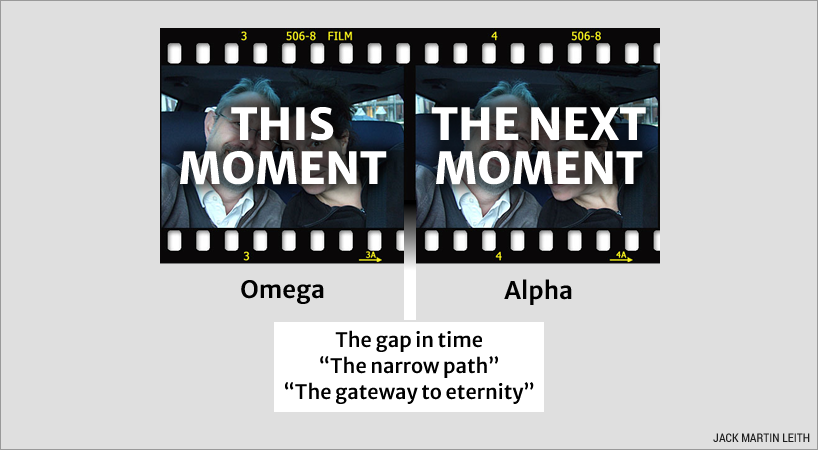
Further readingThe gateway to the narrow path is: Omega – Alpha.
The one who passes through it bodily – in time – steps into death.
The one who passes through it spiritually – beyond time – steps into eternity.
Can you measure time between Omega and Alpha?
A fleeting instant ends – a new instant begins.
Between the two, there is no time.
BETWEEN THEM IS ETERNITY.
There is a gateway to eternity:
It opens not at the beginning, but at the end.
The Creator sets in motion
and the new instant is;
the old is no more.AT THE DEATH OF EACH INSTANT
YOU CAN ENTER INTO ETERNITY,
INTO THE CREATING WORLD.
AND THERE YOU – YOURSELF – SET IN MOTION.The Angels | Capitalisation as found in the book Talking with Angels | Read more here: The truly new comes from nothing
The truly new comes from nothing
Carlos Castaneda
In the Carlos Castaneda books, don Juan describes intent as “the force that creates and animates the universe”. The term Divine energy also appears.
Napoleon Hill
In his 1937 bestseller Think and Grow Rich!, Napoleon Hill uses the term Infinite Intelligence.
“Infinite Intelligence” is the term Hill uses to describe “God,” or “Divine Power,” or the “Supreme Being” at work in the universe and whose influence is felt everywhere within it. His conception of God, or Infinite Intelligence, is richly textured and multi-faceted. God, to Hill, is more than a divinely spiritual, personal, moral force. God is a source of intelligence, direct communication, and exchange of information—between the Supreme Intelligence itself and the individual, and even between individuals. It is clear that Hill writes primarily from a Judeo-Christian perspective, but his view of Infinite Intelligence is nonsectarian and widely encompassing. As you read the book, notice how Hill sees Infinite Intelligence at work in the lives of Jesus, Gandhi, and Mohammed, as well as in all individuals whose mental states are “attuned” to the power of Infinite Intelligence. Hill is never “preachy” about Infinite Intelligence and how one should respond to it, but to fully understand and utilize The Think and Grow Rich Philosophy, it is necessary to understand the part that Infinite Intelligence—God—plays in it.
Ross Cornwell, Endnotes, Think and Grow Rich! The Original Version, Restored and Revised | Download pdf—397 pages
How is the mundane transcended?
We all shift into primal world under certain conditions — for example when walking in nature (particularly when close to water), sitting in the sun, dancing or listening to music. Newcreators must be able to do so at will.
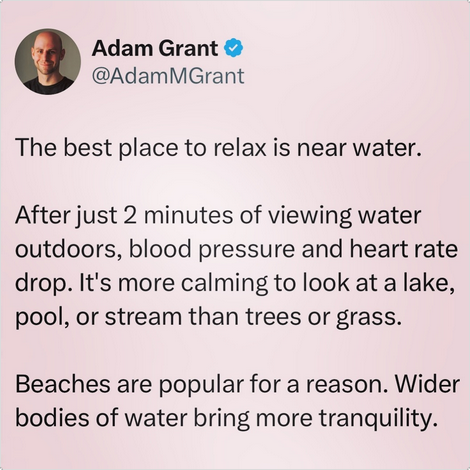
This social media post by organisational psychologist Professor Adam Grant was prompted by the research findings reported below.
“Drifting is a special form of attention where we are engaged with the world around us but not focused on getting something done.” In Newcreate terms, we have left mundane world and entered primal world.In the book Blue Mind, marine biologist Wallace J. Nichols states “Being near water allows us to access a semi-meditative state known as ‘drifting’. Drifting is a special form of attention where we are engaged with the world around us but not focused on getting something done.”
A study done by the University of California Davis showed that just looking at a body of water can decrease heart rate and blood pressure.
There is a reason why many of us enjoy sitting near rivers, lakes and beaches. Being near natural water is one of the powerful ways to nurture the nervous system.
Reference: Richard G. Coss, Craig M. Keller, Transient decreases in blood pressure and heart rate with increased subjective level of relaxation while viewing water compared with adjacent ground | Journal of Environmental Psychology, Volume 81, 2022, 101794 | Download pdf
Source: Instagram, @scienceofessentials
When I am in London, I wake up early, walk through the woods with some other wild swimmers, and jump into the lake. During winter, with water temperatures dropping to freezing, this is nothing less than a catastrophic outrage to the nervous system and an excruciatingly intimate engagement with one’s mortality.
This encounter obliterates all anger and worldly woes. To quote Roger Deacon’s beautiful book, Waterlog, you plunge into the lake with all your raging devils and clamber out ‘a giggling idiot’. In icy water, with our adrenaline and endorphins running riot, we are returned to our innocent, primordial selves via an internal ecstatic screaming to be born defiantly afresh. We become tiny creatures in the shock of nature, and, Freya, we are made happy!
As my friends and I make our way back through the woods, borne on the wings of God’s laughing angels, in the grip of some massive dopamine surge, we understand we are better now. This sense of delight, this shivering joy, will remain with us as we go about our day.
Nick Cave, on his Red Hand Files website, responding to Freya’s question “What makes you happy?” | View Nick Cave’s response in full
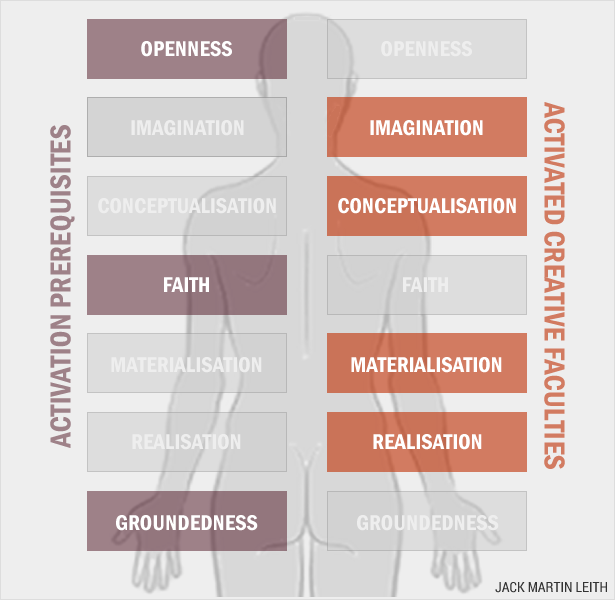
The seven creative powers: activation prerequisites (states of being) and activated creative faculties
If it can be perceived that the consensual reality possesses a rudimentary ‘hive mind’, it then becomes possible to see that this hive mind is predatory in nature, in that it invades and usurps the individual unless the individual has mastered extreme awareness. In other words we may be ‘taken over’ by the consensual hive, whose primary agenda is to preserve its static status quo. Other – more extreme – definitions have been offered for the predatory mind, and may in fact, have truth as well.
Della Van Hise | View source
To escape, you first need to recognise you’re confined.
Darran Anderson, Nick Cave’s doctrine of doubt, on UnHerd website
In your everyday life, you can transcend the mundane by means of the breathing cycle described below.
Before you begin, you must be in a state of faith, with all rules, norms, codes, beliefs, dogmas, narratives and ideologies packed into a suitcase and left in a locker to be reclaimed later.
Having done that, imagine a satellite dish perched on top of your head, acting as a receiver of intent’s originating aspect.
Also imagine an earth rod connecting your tailbone to the ground beneath your feet, acting a receiver of the fulfilling aspect.
Choose a sacred name for each aspect. The names are not really that important as long as they are respectful and you feel comfortable using them.

As you slowly inhale, imagine intent’s fulfilling aspect rising from the earth, all the way up your spine to the top of your head where the satellite dish sits8. While this is happening, subvocalise the name you have chosen for this aspect.
And as you slowly exhale, imagine drawing the originating aspect down from the satellite dish, all the way down your spine to your tailbone, then down through the earth rod and into the ground9. While this is happening, subvocalise the name you have chosen for this aspect.
Continue with this breathing cycle for several minutes, all the while noticing the energy mounting in your heart10. This is the energy that powers unconditional service: unconditional love made manifest.
With practice, the breathing cycle will become second nature and you will simply inhale and exhale while subvocalising the sacred names.
8. Creative power: Openness.
9. Creative power: Groundedness.
10. Creative power: Faith.
Endnotes
You have made it all the way through to the conclusion of this challenging essay. Thank you for your patience and persistence.
Please turn to the index for a deeper exploration of the Newcreate way of thinking, doing and being..
The websites, web pages and articles listed below may also help you in your quest to transcend the mundane, create the new and enrich the world with value, meaning and joy.
You are welcome to contact me by email or contact form if you have any questions, comments or contributions.
I wish you a lifetime of joyful and fruitful Newcreating, and remain at your service.
Jack Martin Leith
Bristol, United Kingdom
Download a pdf version of this article
Continue reading
External websites
The Energetic Marriage of Love & Intent, by Della Van Hise
Four Stages of Groundedness, by John J. Prendergast
Intent, by Lorraine Voss
Intent versus Intention; Is there a difference? by Sheri Rosenthal
The Toltec Power of Intent, by Théun Mares
Immediate Learning Method, by Anthony Blake, who developed the method in collaboration with Edward Matchett
The Manifest and the Unmanifest, by Peter Russell
My stroke of insight, a TED talk given by neuroanatomist and author Jill Bolte Taylor, in which she talks eloquently about her experience of living through a massive left hemisphere stroke
Readers reply: what are thoughts? Where do they come from – and where do they go? (short answer: no one knows) on The Guardian website
River Kenna outlines various ways of balancing the hemispheres in this Substack
There Is No Such Thing as Conscious Thought, by Steve Ayan, on Scientific American website
This website
Creative Victory — a discourse on the collected works of Carlos Castaneda, by Tomas
Edward Matchett: industrial design and create-the-new pioneer
Experiencing divine wisdom in ordinary living, by Edward Matchett
How Newcreators use mind, body and spirit to create the new and enrich the world
Iain McGilchrist and his theory of brain hemisphere differences
Imagination — two forms: synthetic and creative
Quotes about the power of creative imagination
Seven creative powers and three superpowers
Transcend the mundane (this page)
Synthetic imagination and creative imagination
Talking with Angels — origin and themes
The truly new comes from nothing
Index to entire site (60+ pages)
Search the site
Not case sensitive. Do not to hit return.





























